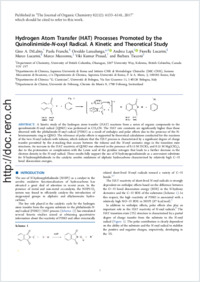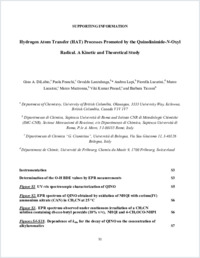Hydrogen atom transfer (HAT) processes promoted by the quinolinimide-N-oxyl radical: a kinetic and theoretical study
- DiLabio, Gino A. Department of Chemistry, University of British Columbia, Kelowna, British Columbia, Canada
- Franchi, Paola Dipartimento di Chimica “G. Ciamician”, Università di Bologna, Italy
- Lanzalunga, Osvaldo Dipartimento di Chimica, Sapienza Università di Roma and Istituto CNR di Metodologie Chimiche, Sapienza Università di Roma, Italy
- Lapi, Andrea Dipartimento di Chimica, Sapienza Università di Roma and Istituto CNR di Metodologie Chimiche, Sapienza Università di Roma, Italy
- Lucarini, Fiorella Département de Chimie, Université de Fribourg, Switzerland
- Lucarini, Marco Dipartimento di Chimica “G. Ciamician”, Università di Bologna, Italy
- Mazzonna, Marco Dipartimento di Chimica, Sapienza Università di Roma and Istituto CNR di Metodologie Chimiche, Sapienza Università di Roma, Italy
- Prasad, Viki Kumar Department of Chemistry, University of British Columbia, Kelowna, British Columbia, Canada
- Ticconi, Barbara Dipartimento di Chimica, Sapienza Università di Roma and Istituto CNR di Metodologie Chimiche, Sapienza Università di Roma, Italy
-
16.06.2017
Published in:
- The Journal of Organic Chemistry. - 2017, vol. 82, no. 12, p. 6133–6141
English
A kinetic study of the hydrogen atom transfer (HAT) reactions from a series of organic compounds to the quinolinimide-N-oxyl radical (QINO) was performed in CH3CN. The HAT rate constants are significantly higher than those observed with the phthalimide- N-oxyl radical (PINO) as a result of enthalpic and polar effects due to the presence of the N-heteroaromatic ring in QINO. The relevance of polar effects is supported by theoretical calculations conducted for the reactions of the two N-oxyl radicals with toluene, which indicate that the HAT process is characterized by a significant degree of charge transfer permitted by the π-stacking that occurs between the toluene and the N-oxyl aromatic rings in the transition state structures. An increase in the HAT reactivity of QINO was observed in the presence of 0.15 M HClO4 and 0.15 M Mg(ClO4)2 due to the protonation or complexation with the Lewis acid of the pyridine nitrogen that leads to a further decrease in the electron density in the N-oxyl radical. These results fully support the use of N-hydroxyquinolinimide as a convenient substitute for N-hydroxyphthalimide in the catalytic aerobic oxidations of aliphatic hydrocarbons characterized by relatively high C–H bond dissociation energies.
- Faculty
- Faculté des sciences et de médecine
- Department
- Département de Chimie
- Language
-
- English
- Classification
- Chemistry
- License
-
License undefined
- Identifiers
-
- RERO DOC 305055
- DOI 10.1021/acs.joc.7b00687
- Persistent URL
- https://folia.unifr.ch/unifr/documents/306103
Other files
Statistics
Document views: 87
File downloads:
- pdf: 568
- Texte intégral: 180

